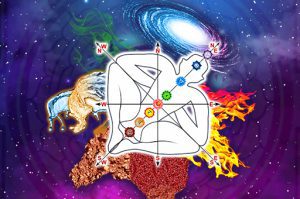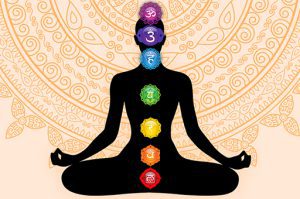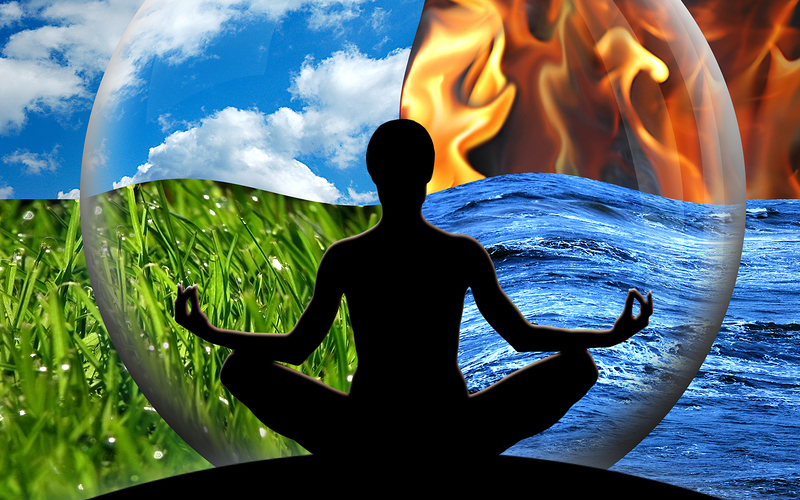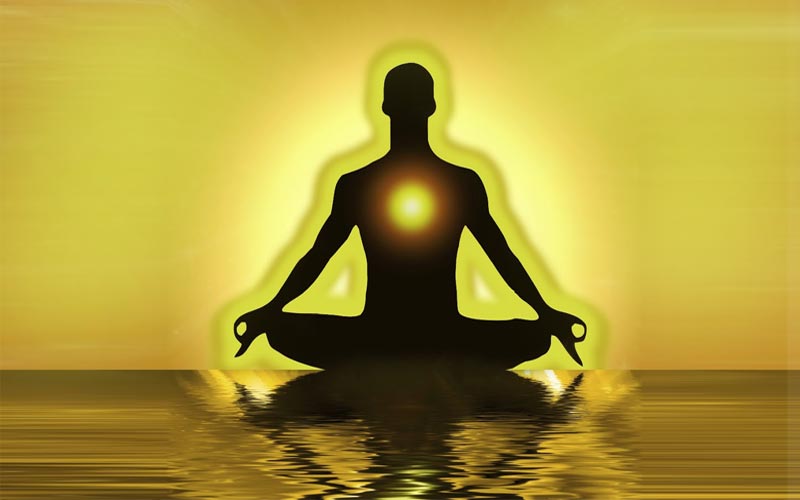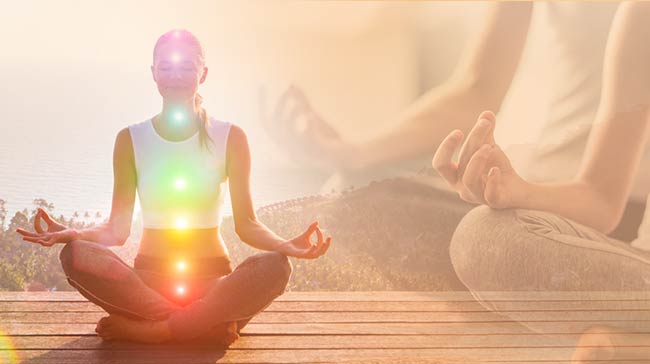
Meditation is a technique for training the mind, much like fitness is a technique for training the body. And, just as the physical benefits of body training accumulate, so do the mindful benefits of meditation.
Meditation is the art of doing nothing and letting go of all exertions to relax in your true nature, which is love, joy, and harmony.
The word ‘meditation’ originates from the Latin word meditatum, which means to “concentrate” or “to ponder”. And Dhyan (meditation) comes from dhi which means mind, and yana means to go away.
In meditation, a person uses a technique, such as breathing, mindfulness, or focusing the mind on a specific object, thought, or activity, to train attention and awareness and attain a state that is mentally clear, emotionally calm, and physically stable.
Within the yoga tradition exists an exquisite methodology designed to reveal the interconnectedness of all living things. This fundamental oneness is known as advaita. Meditation is the experiential realization of this union.
Patanjali’s Yoga sutras (circa 400 CE), a text associated with Yoga and Samkhya that details eight limbs leading to kaivalya, is one of the most influential texts of classical Hindu Yoga (“aloneness”). These include ethical discipline (yamas), rules (niyamas), physical postures (asanas), breath control (pranayama), sense withdrawal (pratyahara), one-pointedness of mind (dharana), meditation (dhyana), and finally samadhi.
In the Yoga Sutras, Patanjali instructs on how to meditate and outlines the components of a meditation practice. According to the second sutra of the first chapter, yoga (or union) occurs when the mind becomes still. This mental tranquility is achieved by balancing the body, mind, and senses, which in turn calms the nervous system.
Patanjali continues by explaining that meditation commences when we realize that our never-ending pursuit of material possessions and insatiable desire for pleasure and safety can never be satisfied. When we finally comprehend this, our external quest becomes inward, and we enter the realm of meditation.
In Advaita Vedanta jivatman, an individual self is understood to be illusory and identical to the omnipresent and nondual Atman-Brahman in reality. In the dualistic Yoga and Samkhya schools, the Self is referred to as Purusha, a consciousness unaffected by Prakriti, or “nature.” According to tradition, the event of liberation is known as moksha, vimukti, or kaivalya.
People have always erroneously believed meditation to be an activity. It is actually a quality. This is a fundamental distinction. Prayer is an attempt to communicate with God. You are attempting to communicate your vows, expectations, or whatever else to him. Meditation implies a willingness to simply listen to existence, the ultimate nature of creation. You are speechless, so you simply listen. This is Nandi’s characteristic; he simply sits, alert. This is crucial: he is vigilant. He is neither drowsy nor passively seated. He is sitting with great activity, alertness, and vitality, but without expectation or anticipation. That is the practice of meditation. Just waiting, for no particular reason.
If you simply wait without taking action, existence will do its own thing. Meditation entails that the individual is not acting independently. He is merely present. Once you are simply there, you become aware of the larger, always-active dimension of existence. You realize that you are a component of it. You are a part of it even now. The realization that “I am a part of it” is meditation. This is symbolized by Nandi. He reminds everyone, “You must sit like me.”
Numerous religious traditions practice meditation. The Upanishads contain the earliest references to meditation (dhyana). In Jainism, Buddhism, and Hinduism, it plays an important role.
Benefits of Meditation
The practice of meditation induces profound relaxation. Reducing stress levels and maintaining mental hygiene are essential.
Meditation has many benefits, including a calm mind, focused attention, good concentration, mental and emotional clarity, balanced emotions in stressful situations, and enhanced communication skills, the surge of new talents, unshakeable inner strength, healing powers, the ability to connect with an inner spring of energy, relaxation, rejuvenation, and the ability to attract good fortune. All of these are natural outcomes of regular meditation practice.
In the 1970s, Herbert Benson, MD, a researcher at Harvard University Medical School, conducted research on people who practiced transcendental meditation and found that it causes a reduction in the activity of the sympathetic nervous system and the activation of the parasympathic system. He called it the relaxation response.
Due to this, a person has:
- Lower blood pressure
- Improved blood circulation
- Lower heart rate
- Less perspiration
- Slower respiratory rate
- Less anxiety
- More feelings of well-being
- Less stress
The ultimate benefit of meditation, according to Buddhist philosophy, is the liberation of the mind from attachment to things it cannot control, such as external circumstances or internal emotions. The liberated or “enlightened” individual no longer follows desires or clings to experiences needlessly, but instead maintains a calm mind and sense of inner harmony.
Daily meditation is no longer a luxury, but a necessity. To achieve unconditional happiness and mental tranquility, we must tap into the power of meditation. Even to be able to progress in a society that constantly dazzles us with external stimuli that startle our minds, it is necessary to “meditate as if your life depends on it.”
The Purpose of Meditation
The purpose of meditation is to generate calmness, freedom from stress, health, and contentment. It is the part of the path that leads to awakening and nirvana. It seeks to attain and maintain the pure state of soul, which is thought to be pure consciousness, devoid of all attachments and aversions. The practitioner aspires to be merely a seer-knower (Gyata-Drashta).
You are retraining your brain. You are quieting your thoughts, being present – what some refer to as mindfulness – and as you begin to truly practice, you connect with the energy and vibrations of the Universe – with All That Is. You are synchronizing the right and left hemispheres of the brain and gaining access to the unconscious’s deepest regions. You are in the flow, and you gradually begin to see how your life begins to flow. Meditation automatically balances the Sacral or Swadhisthana chakra (emotions) and opens up the Crown or Sahasrara chakra (thoughts) towards complete enlightment and oneness with the whole.
Meditation for beginners

Meditation is as simple as listening to our breath inhale and exhale. It does not require you to attend yoga classes or retreat to the mountains in seclusion. It is a practice that is easily incorporated into daily life. You can choose from a variety of meditation techniques, all of which facilitate an effortless return to the present moment.
In fact, in the very first sitting, the experience of a great number of people has been so extraordinary that they find it difficult to put it into words. As you practice meditation regularly, perhaps once or ideally twice per day, you begin to feel a transformation from the inside out, to the point where others begin to recognize the beautiful energy you exude. Therefore, everyone should meditate daily for a few minutes in order to live a happy and stress-free life.
Why do you need meditation?
Perhaps you’ve read about the long-term advantages of meditation and would like to experience them for yourself (including decreased symptoms of depression, anxiety, and stress, and increased mental focus). You may admire the few minutes of guided meditation your yoga instructor incorporates into each class and, as a consequence, wish to grow the practice on your own time. Or perhaps you haven’t attempted meditation yet because you haven’t discovered a practice that resonates with you (there are plenty!).
Establishing a regular meditation practice can help to calm the chattering “monkey mind” that yogis frequently allude to, and it can assist us in gaining a greater awareness of ourselves. And deep rest is the foundation for complete alertness.
So where do you begin?
How to meditate
- Sit or lie comfortably.
- Close your eyes.
- Breathe naturally.
- Focus your attention on the breath.
- Use your japa mala if needed to keep it going.
Which Type of Meditation Should You Practice?
Mindfulness, which is the foundation of meditation, may improve many aspects of our life. Following is a summary of seven types of meditation and their respective benefits.
1. MINDFULNESS MEDITATION
In mindfulness meditation, the breath is used as the focal point of attention. When distractions arise, simply observe them without attachment, and then bring your focus to your breath. Feeling bored? No problem, just recognize your boredom! Wondering if you’re performing meditation incorrectly? That’s fine; just be aware that you are thinking this. Feeling wiggly? Notice that you are moving while you wiggle. Observing distractions as they arise, without becoming overly fixated on them, enables us to return to the breath and remain in the present moment more quickly.
Mindfulness meditation can be beneficial as a stress reliever and at any other time you feel the need to regain your composure and breathe deeply. Meditation engages the parasympathetic nervous system, which has multiple healing effects on the body. It reduces cortisol levels and increases blood flow, resulting in a sense of relaxation.
2. FOCUSED MEDITATION
This form of meditation entails concentrating on a single point while tuning out all other stimuli. This may involve following the breath, repeating a single word or mantra, focusing on a candle flame or an object, listening to a repetitive gong or mantra, or counting beads on a mala. Due to the difficulty of focusing the mind, a beginner may meditate for only a few minutes before progressing to longer sessions. In this type of meditation, each time you become aware of your mind wandering, you simply refocus your attention on the object of attention you have chosen. Instead of following random thoughts, you let them go. This technique improves your ability to concentrate. In this, you focus on cultivating loving-kindness and compassion.
In mantra meditation, rather than focusing solely on the breath, you continuously repeat a mantra, a sound, chant, or phrase. A mantra can be as simple as the sound “Om” or it can be a particular Sanskrit sentence according to your needs. Alternatively, yantra meditation can be practiced by focusing the attention to its central point, as these sacred geometrical figures are physical representations of mantras.
3. MOVING MEDITATION
For some, the physical act of sitting still can be an impediment to beginning a meditation practice or achieving a state of mental calm. Move into active meditation. If seated meditations leave you feeling more restless, anxious, or agitated than when you began, walking meditation may be a better fit for you.
Breath walk is a kundalini yoga practice that encourages practitioners to synchronize their breath with their steps and a traditional kundalini mantra. Ideally, your mind remains focused on something occurring in the present (on the body, the breath, and the mantra), allowing you to let go of other distractions. Focused awareness enables you to take a break from domestic to-do lists, work stress, or any other unproductive chatter that could otherwise cause anxiety or stress.
4. VISUALIZATION MEDITATION
For some, the physical act of sitting still can be an impediment to beginning a meditation practice or achieving a state of mental calm. Move into active meditation. If seated meditations leave you feeling more restless, anxious, or agitated than when you began, walking meditation may be a better fit for you.
Breath walk is a kundalini yoga practice that encourages practitioners to synchronize their breath with their steps and a traditional kundalini mantra. Ideally, your mind remains focused on something occurring in the present (on the body, the breath, and the mantra), allowing you to let go of other distractions. Focused awareness enables you to take a break from domestic to-do lists, work stress, or any other unproductive chatter that could otherwise cause anxiety or stress.
5. BODY SCANNING MEDITATION
This technique involves focusing on one area of your body (the top of your head or the soles of your feet are good places to start), becoming aware of any physical, emotional, or mental sensations you are experiencing in that area, and then setting the intention to release tension. The scan advances throughout the body until all areas have been examined. This practice is particularly advantageous for physical stress (such as chronic tension in your muscles). Many of us subconsciously clench our jaws during times of stress. This can eventually lead to jaw and neck pain, headaches, and dental issues if you routinely clench your teeth in times of stress.
Body scanning meditations allow you to “clean out” the areas that become your personal stress dumpsters and may help you become more conscious of how you hold and manage stress.
6. GAZING MEDITATION
This meditation technique, also known as trataka, involves concentrating on an external object. As focal points, practitioners frequently use the flame of a candle, but other significant objects (such as a crystal, a religious object, or a photograph) that hold personal significance or symbolize a personal intention can also be used. As the duration of your focus increases, you may observe a decrease in your eye movements. Gazing meditations improved neurocognitive functions such as memory, attention, and concentration in older participants, and strengthened their ocular muscles.
7. REFLECTIVE MEDITATION
This is a contemplative and illuminating meditation in which you investigate a specific idea, concept, question, or circumstance in order to receive wisdom from the still, small voice, inner wisdom, or the divine inside you. This is a very helpful guiding technique for those with unresolved concerns, persistent worries, and a lack of life direction.
How Long Should Meditation Last?
As the practice of meditation becomes increasingly popular in all Western cultures, more and more ways are emerging to incorporate it into daily life, but this often results in very simplified forms of meditation that offer no physical, mental, or spiritual benefit because they are not adequate or most commonly, they do not last enough time. They are typically introduced as a pleasant way to relax for a few minutes or as a quick stress reliever, but the benefits of the practice of meditation are far more extensive and require more time. Similarly to when you go to the gym to train and develop your muscles, you must consistently dedicate a certain amount of time every day. Three minutes of daily practice is useless to build muscle mass, the most you can achieve by doing it is a hasty physical high in your body tone. Nothing else, right?
There are various relaxation techniques that you can practice for a few minutes each day to feel better or relieve stress, but these are not meditation, these are just relaxation practices. Meditation entails a training in which we cultivate our concentration and connection to our inner Self, devoid of mental distractions. This means that it takes at least 24 minutes (a traditional Indian unit of time called 1 Ghati) to be able to clear one’s mind and begin to develop some concentration without mental interferences. Keeping this in mind, the minimum recommended time for daily meditation is approximately 45 minutes. Less time is useless.
As with any new habit, consistency is of the utmost importance. As you become more accustomed to meditation, you can gradually extend the length of your sessions. And, as your practice becomes more consistent, you may also notice that you are participating more fully in your daily activities, such as being fully present while responding to a work email or playing with your child, as opposed to mentally attending to multiple impractical concerns and interests.
When is the best time to meditate?
First thing in the day after getting up or shortly after during the early morning is the best time of the day because it is still and quiet, allowing you to enter a deep state of meditation, and sets the tone for the rest of the entire day making it a better, happier and more productive day. Indeed, after just one week of a morning meditation practice, you will begin to experience the powerful benefits of the practice of meditation, such as reduced stress, improved sleep, increased energy, decreased pain, enhanced attention, and decreased anxiety and depression.
Morning meditation Benefits
- Improves Your Mood: By meditating every morning, you can control the mood of your day by increasing positive emotions such as happiness, optimism, and contentment.
- Enhances Your Awareness: Meditation facilitates the examination of one’s thoughts, feelings, and emotions in order to better comprehend and detach from them. Daily practice can help you to handle negative thoughts and increase your appreciation for positive moments. The increased self-awareness and influx of clarity gained from a morning practice will assist you in navigating the day with greater ease and skill.
- Prevents Anxiety and Stress: Meditation stimulates the parasympathetic nervous system, which has a variety of healing effects on the body. It reduces cortisol levels and increases blood flow, resulting in a feeling of relaxation. Numerous studies have demonstrated that meditation makes it easier to resist stress. Establishing a routine can make it simpler to deal with life’s daily frustrations.
- Optimizes Productivity: A morning meditation practice enables you to gain greater control over your responses to temptations and emotional impulses, regardless of the day’s tasks. You can approach tasks with enthusiasm and vigor, enabling you to complete them quickly and effectively. With a greater sense of concentration and vigor, productivity and job satisfaction increase.
- Enhances Generosity and Compassion: Meditation inspires more empathy and less judgment towards others because it reduces tension and heightens emotional sensitivity. Through increased compassion and kindness, you can engage with others from a proactive rather than a reactive state of mind and have more positive experiences. A daily morning ritual can foster a kinder and more compassionate outlook on the world.
Meditation is a lifetime commitment, so we must begin wherever and whenever we can. Relevantly, this becomes a natural progression with consistent practice, and we will not need to force it. It is recommended to meditate every day at a set time and even more to do it twice daily if this is possible for you.



